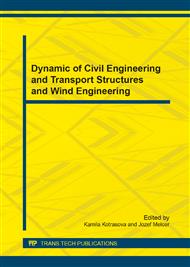[1]
S. Grassi, N. Chokani, R.S. Abhari, Large scale technical and economical assessment of wind energy potential with a GIS tool: Case study Iowa, Energy Policy. 45 (2012) 73-85.
DOI: 10.1016/j.enpol.2012.01.061
Google Scholar
[2]
R. Van Haaren, V. Fthenakis, GIS-based wind farm site selection using spatial multi-criteria analysis (SMCA): Evaluating the case for New York State, Renewable and Sustainable Energy Reviews. 15 (2011) 3332-3340.
DOI: 10.1016/j.rser.2011.04.010
Google Scholar
[3]
B. Sliz-Szkliniarz, J. Vogt, GIS-based approach for the evaluation of wind energy potential: A case study for the Kujawsko-Pomorskie Voivodeship, Renewable and Sustainable Energy Reviews. 15 (2011) 1696-1707.
DOI: 10.1016/j.rser.2010.11.045
Google Scholar
[4]
S.M.J. Baban, T. Parry, Developing and applying a GIS-assisted approach to locating wind farms in the UK, Renewable Energy. 24 (2001) 59-71.
DOI: 10.1016/s0960-1481(00)00169-5
Google Scholar
[5]
N.Y. Aydin, E. Kentel, S. Duzgun, GIS-based environmental assessment of wind energy systems for spatial planning: A case study from Western Turkey, Renewable and Sustainable Energy Reviews. 14 (2010) 364-373.
DOI: 10.1016/j.rser.2009.07.023
Google Scholar
[6]
L. -I. Tegou, H. Polatidis, D.A. Haralambopoulos, Environmental management framework for wind farm siting: Methodology and case study, Journal of Environmental Management. 91 (2010) 2134-2147.
DOI: 10.1016/j.jenvman.2010.05.010
Google Scholar
[7]
S. Grassi, N. Chokani, R.S. Abhari, Large scale technical and economical assessment of wind energy potential with a GIS tool: Case study Iowa, Energy Policy. 45 (2012) 73-85.
DOI: 10.1016/j.enpol.2012.01.061
Google Scholar
[8]
V. Gass, J. Schmidt, F. Strauss, E. Schmid, Assessing the economic wind power potential in Austria, Energy Policy. 53 (2013) 323-330.
DOI: 10.1016/j.enpol.2012.10.079
Google Scholar
[9]
W. Krewitt, J. Nitsch, The potential for electricity generation from on-shore wind energy under the constraints of nature conservation: A case study for two regions in Germany, Renewable Energy. 28 (2003) 1645-1655.
DOI: 10.1016/s0960-1481(03)00008-9
Google Scholar
[10]
J. Malczewski, GIS-based land-use suitability analysis: a critical overview, Progress in Planning. 62 (2004) 3-65.
DOI: 10.1016/j.progress.2003.09.002
Google Scholar
[11]
E.V. Ivanova, D.V. Smirnov Estimation methodology of wind energy potential in Russian Federation, Transactions of the Main Geophysical (A.I. Voeikov) Observatory. 559 (2009) 113-120.
Google Scholar
[12]
A.K. Monzikova, V.N. Kudryavtsev, E.S. Larsen, B. Chapron, Estimation wind power potential of the Gulf of Finland, Proceedings of the Russian State Hydrometeorological University. 30 (2013) 116-133.
Google Scholar
[13]
O. Probst, D. Cárdenas, State of the Art and Trends in Wind Resource Assessment, Energies. 3 (2010) 1087-1141.
DOI: 10.3390/en3061087
Google Scholar
[14]
D. Kurtener, V. Badenko, GIS fuzzy algorithm for estimating the quality of soil parameter Evaluation of attribute data quality, Geomatics Info Magazine. 15 (2001) 76-79.
Google Scholar
[15]
D. Kurtener, V. Badenko, A GIS methodological framework based on fuzzy sets theory for land use management, Journal of the Brazilian Computer Society. 6 (2000) 26-32.
DOI: 10.1590/s0104-65002000000100004
Google Scholar
[16]
N.V. Aref'ev, V.L. Badenko, G.K. Osipov, Basin-landscape approach to the organization of environmental monitoring of hydropower complexes on the basis of geographical information technologies, Power Technology and Engineering. 32 (1998) 660-663.
DOI: 10.1007/bf02446346
Google Scholar


